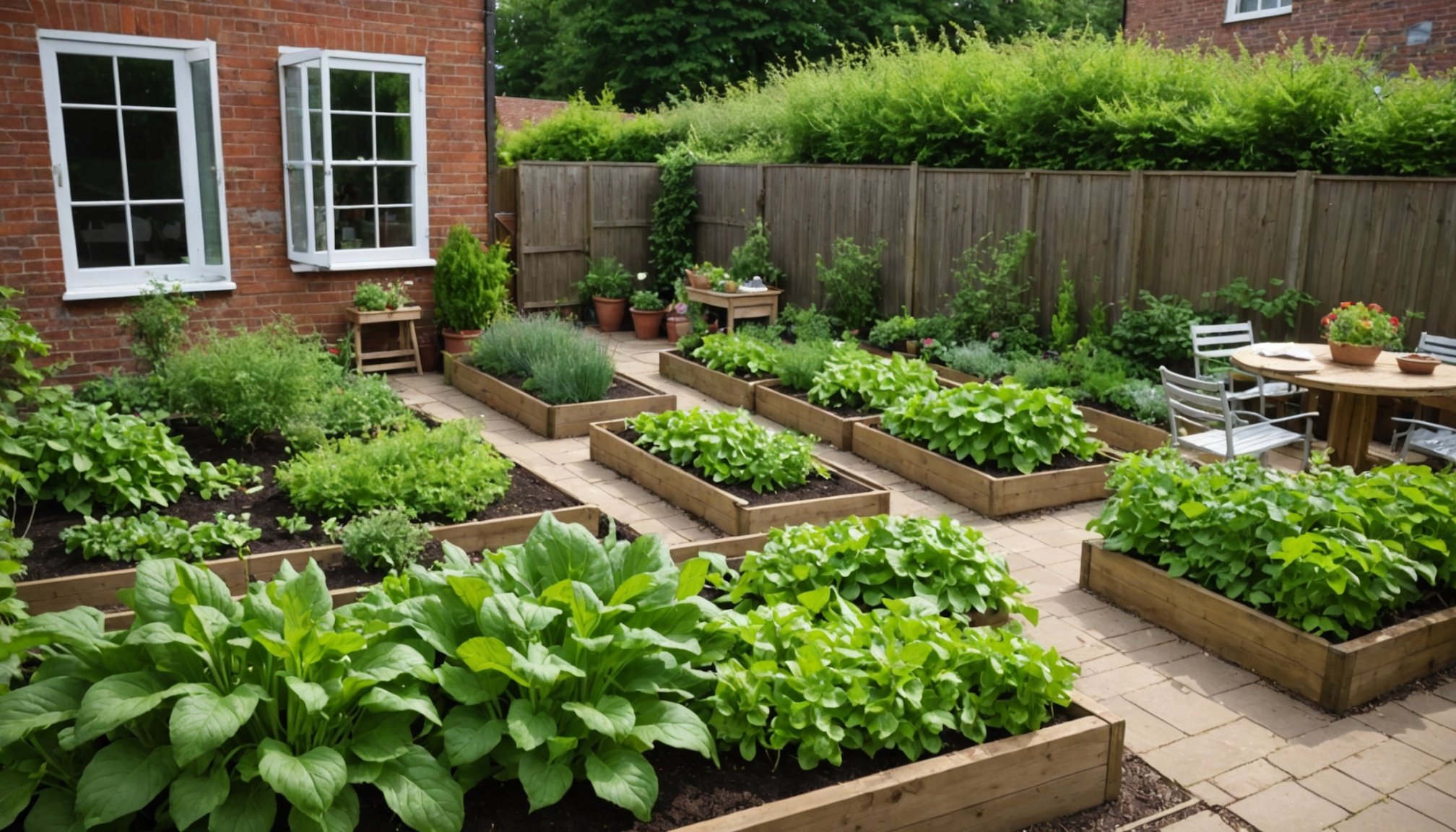Understanding the UK Climate
The UK climate for gardening can be quite unique due to its varied climate zones. From the mild conditions of the South-West to the cooler, wetter conditions in Scotland, the UK presents challenges and opportunities for vegetable gardening.
Overview of Climate Zones in the UK
Each zone has specific characteristics that can affect plant growth. For instance, the south-eastern regions experience warmer and drier summers, ideal for warm-weather crops, while the northern areas face cooler temperatures that favour cold-resistant vegetables.
Also to discover : Unlocking the secrets to a flourishing uk garden: effective natural pest management techniques
Seasonal Weather Patterns and Their Impact
Seasonal changes greatly influence gardening practices. Winters can be harsh, often requiring protection methods for perennial plants, while springs might be wet, demanding careful drainage planning to prevent waterlogging. Summers, usually mild, can support a wide variety of vegetables but necessitate consistent watering especially in dry spells.
Importance of Microclimates in Courtyards
Courtyards can develop their own microclimates. Walls and structures can trap heat, extending the growing season for some plants. They can also offer shelter from strong winds. It’s crucial to recognize these small climate variations within your property as they present an opportunity to grow a broader range of vegetables tailored to specific conditions.
Preparing the Soil
Soil preparation techniques play a critical role in establishing a productive garden, especially in the UK where soil conditions can vary greatly. To begin, it’s essential to assess soil quality and texture. Testing soil pH and understanding its composition—whether it’s sandy, clay, or loamy—can guide the necessary amendments for optimal plant growth.
Once you have assessed your soil, consider amendment options for nutrient enhancement. Incorporating organic matter like compost or well-rotted manure can greatly improve soil fertility and structure. These enrichments help establish a thriving environment for plant roots, enabling better water and nutrient uptake.
In the often small spaces of UK courtyards, tips for improving drainage are crucial. Poor drainage can lead to waterlogged conditions that stunt plant growth. To counter this, consider the following strategies:
- Elevate planting beds to enhance water runoff.
- Mix in coarse sand or grit to improve soil permeability.
- Install drainage pipes or create a gentle slope to direct excess water away.
By investing time and effort into soil preparation, gardeners can overcome initial hurdles and lay the foundation for successful vegetable cultivation in small, UK-specific garden settings.
Choosing the Right Vegetables
Selecting the appropriate vegetable varieties is pivotal for success in small UK courtyards. With limited space available, focusing on plant selection for small spaces becomes important to maximise yield. Choosing compact, high-yield varieties such as cherry tomatoes, dwarf beans, and chilli peppers can ensure productive use of space. These plants generally require less room to thrive yet offer significant harvests.
Utilising companion planting strategies can enhance growth and deter pests. Pairing vegetables like onions with carrots can repel carrot flies, while marigolds can naturally repel nematodes when planted alongside tomatoes. Companion planting not only optimises space but also supports ecological gardening by fostering symbiotic relationships.
Exploring the use of heirloom seeds adds another dimension to diverse produce options. These seeds maintain genetic variations that modern hybrids often lack, ensuring rich flavours and resilience to local conditions. They often come from open-pollinated plants, preserving unique traits passed through generations. Available through UK seed libraries and specialised seed companies, heirloom seeds offer a way to explore unique, often traditional, vegetable varieties.
By carefully selecting vegetables suitable for small spaces, employing intelligent planting techniques, and considering heirloom varieties, gardeners can effectively cultivate a variety of produce tailored to their specific courtyard environment.
Implementing Vertical Gardening Techniques
In small UK courtyards, space can be a significant limitation. Here, vertical gardening methods offer a powerful solution by making use of vertical space to maximize your gardening potential.
Benefits of Vertical Gardening
Vertical gardening allows gardeners to grow a variety of plants in otherwise unused areas, like walls and fences. This not only saves space but also provides better air circulation, reducing the risk of plant diseases.
Structures and Tips for DIY Vertical Gardens
When planning your vertical garden, consider structures like trellises, hanging pots, or wall-mounted planters. Building a sturdy frame is crucial, as it supports your plants and helps maintain an organised garden. Here are some tips:
- Use lightweight materials to prevent structural strain.
- Incorporate a drip irrigation system to ensure consistent watering.
Recommended Plants for Vertical Setups
Certain plants thrive in vertical gardens due to their growth habits. Climbing and trailing plants such as peas, beans, and strawberries are excellent choices. These can easily wrap around or drape from their supports, making efficient use of the available space. Furthermore, herbs like thyme and mint can be planted in wall-mounted containers for a fresh and convenient harvest.
Container Gardening Essentials
To cultivate a thriving vegetable garden within limited spaces, understanding key container gardening tips is essential. Selecting appropriate containers is the first step. Look for containers with adequate drainage holes to prevent waterlogging, which can stunt plant growth. Materials such as lightweight plastic or fabric pots can be easier to move and more flexible in positioning.
A well-balanced soil mixture is crucial for container success. A combination of potting soil, perlite, and vermiculite ensures good drainage while retaining necessary moisture and nutrients. Consistent watering is key, especially during dry spells, as containers tend to dry out quicker than traditional garden beds. Monitoring the soil moisture and adjusting watering routines as needed will promote healthy growth.
Creativity can enhance space usage when arranging containers. Stack pots vertically or arrange them in tiered layers to implement vertical gardening methods in your design. Hanging baskets and wall-mounted containers are also innovative solutions for maximising space. By employing these techniques, gardeners can cultivate a wide range of vegetables and herbs, even in compact settings, making the most out of their available area. This approach not only optimizes space but also adds unique visual interest to the garden setting.
Maintenance Strategies for a Thriving Garden
Effective gardening maintenance practices are crucial to ensuring the ongoing health and productivity of your UK courtyard garden. Regular tasks form the backbone of a successful garden, particularly in small spaces where plants can become stressed quickly.
Regular Watering and Fertilisation Routines
Establishing a consistent watering schedule is vital. Given the variable UK climate, adjust frequencies based on seasonal changes to prevent both drought stress and overwatering. Use soil moisture meters to guide your decisions, ensuring plants receive the right amount of water. Fertilisation is equally important; choose a balanced, slow-release option to supply nutrients consistently. Apply this carefully to avoid nutrient burn.
Pest Management Strategies Tailored for Small Gardens
Pests can have a significant impact. Implement natural pest management strategies to protect plants. Use methods such as introducing beneficial insects or companion planting to deter common pests like aphids or slugs. Netting can prevent damage from birds and other larger creatures.
Seasonal Maintenance Tasks
Plan for seasonal maintenance tasks to keep plants healthy year-round. In spring, prune and thin overcrowded plants. During autumn, clear away debris to prevent diseases from spreading. By maintaining a consistent upkeep routine and adapting to seasonal demands, your courtyard garden will flourish.
Visual Layout Ideas for Courtyards
Designing an efficient courtyard garden requires creative planning to make the most of limited space. By integrating thoughtful layout ideas, you can maximise plant growth while maintaining an accessible and visually pleasing environment.
Diagrams of Optimal Layouts for Space Utilization
Visualising your space with diagrams can significantly enhance garden planning. For example, adopting a centralised layout with paths around the perimeter optimises space, enabling easy access to plants. Consider adding a focal point such as a decorative water feature or a fruit-bearing tree to create a vibrant yet structured garden setting.
Incorporating Pathways and Seating for Accessibility
Pathways improve accessibility and can be designed using gravel or stepping stones to reduce maintenance while enhancing garden aesthetics. Incorporate seating areas to enjoy your garden’s beauty and tranquillity, turning a practical space into a peaceful retreat.
Examples of Successful UK Courtyard Vegetable Gardens
Take inspiration from successful UK courtyard gardens, which often feature a harmonious balance between vertical plantings and traditional arrangements. Look for examples that integrate diverse plant selection for small spaces, showing that a mix of climbing plants, container arrangements, and green living walls can lead to a thriving courtyard garden.
Resources and Community Initiatives
In the journey of cultivating a vibrant garden, tapping into local gardening resources can enhance your experience and success. These resources offer invaluable support ranging from practical gardening advice to community engagement opportunities.
Links to UK Gardening Organizations
Numerous UK-based gardening organizations provide essential guidance for both novice and experienced gardeners. These organizations can offer resources such as seeds, workshops, and expert advice to help you navigate various gardening challenges. They act as a backbone for community support, fostering a spirit of collaboration among gardening enthusiasts.
Community Gardening Initiatives
Participating in community gardening initiatives brings additional benefits beyond the garden itself. These projects encourage knowledge exchange, offer access to shared resources, and promote sustainable practices. Being part of such initiatives can uplift your gardening experience while contributing to greener urban spaces.
Local Workshops and Events
Workshops and events provide hands-on learning experiences that are invaluable for practical skill development. Attending these can enhance your understanding of gardening techniques, from soil preparation to pest management strategies. Local events also provide an opportunity to engage with like-minded individuals, creating a network of gardening friends and mentors.
By utilising these community-based resources, gardeners can expand their knowledge, gain support, and contribute meaningfully to local environmental improvement efforts.











